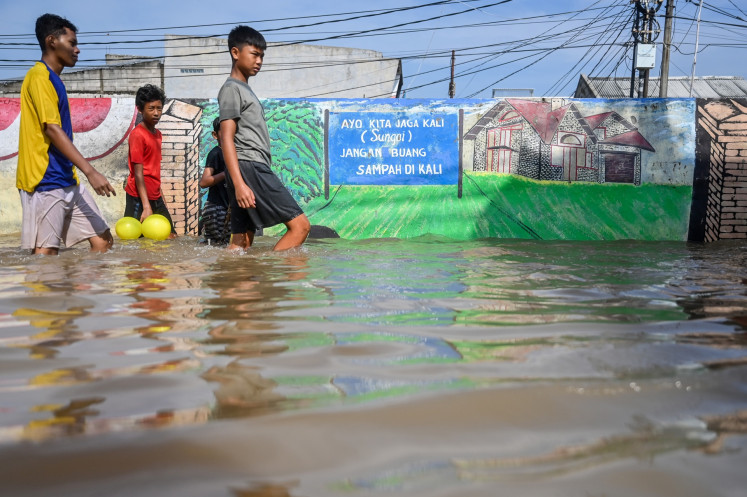Popular Reads
Top Results
Can't find what you're looking for?
View all search resultsPopular Reads
Top Results
Can't find what you're looking for?
View all search resultsA 'quiet story' of Alzheimer's disease in Kemang
Stillness: The images point to the ordinariness of the condition and its potential effects on anyone
Change text size
Gift Premium Articles
to Anyone
 Stillness: The images point to the ordinariness of the condition and its potential effects on anyone. (JP/Jerry Adiguna)" border="0" height="333" width="500">Stillness: The images point to the ordinariness of the condition and its potential effects on anyone. (JP/Jerry Adiguna)
Stillness: The images point to the ordinariness of the condition and its potential effects on anyone. (JP/Jerry Adiguna)" border="0" height="333" width="500">Stillness: The images point to the ordinariness of the condition and its potential effects on anyone. (JP/Jerry Adiguna)What happens when our memories are taken from us, slowly, piece by piece, until there is nothing but emptiness?
Alzheimerâs disease, first described in 1906, is the most common cause of dementia, affecting more than 6 billion people in the world, according to the World Health Organization (WHO).
In the Asia-Pacific region alone, the number of dementia cases is expected to jump from 13.7 million to 64.6 million, with more than 3 million cases in Indonesia, by 2050.
It is a largely invisible and unheard of disease; its sufferers are most often the elderly. As a disease of the brain, the progressive ravages of Alzheimerâs are also invisible. Memory loss and mood swings are often hidden beneath an otherwise healthy body.
In referencing such a disease, the title of Arabella Plouviez photography series âAlzheimerâs: A Quiet Storyâ inevitably draws emotional attention to itself.
 Reflections: Viewers are provoked to reflect on feelings of absence and confusion and upon what has been lost, hidden or forgotten.
Reflections: Viewers are provoked to reflect on feelings of absence and confusion and upon what has been lost, hidden or forgotten.
Yet in their reticent anonymity, the images point to the ordinariness of the condition and its potential effects on anyone.
It is the experiential aspects of the disease that are referenced in the images, not science or medicine. The pictures speak eloquently of lived absences and of experiences that are beyond visibility and representation.
Looking at the pictures, Plouviezâs narrative approach allows spectators to contemplate and feel the traces of their existence to give an imaginative understanding of how it must feel to suffer from Alzheimerâs.
The images present an empty stillness in once cheerful spaces, provoking viewers to reflect on feelings of absence and confusion, and upon what has been lost, hidden or forgotten.
As a professor and the head of photography at the University of Sunderland in the UK, Plouviez has been shooting for years.
Her other projects have, for example, explored women prisoners in a high security prison and the representation of women in Northern England, among other subjects.
âThis work takes a domestic environment, which has been lived in for a lifetime, and the medium of photography, which we so often use as our memory, to explore some of the changes and loss that comes with Alzheimers,â Plouviez said in her artistâs statement for the exhibition.
Stillness: The images point to the ordinariness of the condition and its potential effects on anyone. (JP/Jerry Adiguna) What happens when our memories are taken from us, slowly, piece by piece, until there is nothing but emptiness? Reflections: Viewers are provoked to reflect on feelings of absence and confusion and upon what has been lost, hidden or forgotten. Contemplative: With a silent narrative approach, Arrabella has exposed local photographers to a different style of visual storytelling that is more contemplative, still and very powerful. (JP/Jerry Adiguna)
Alzheimer's disease, first described in 1906, is the most common cause of dementia, affecting more than 6 billion people in the world, according to the World Health Organization (WHO).
In the Asia-Pacific region alone, the number of dementia cases is expected to jump from 13.7 million to 64.6 million, with more than 3 million cases in Indonesia, by 2050.
It is a largely invisible and unheard of disease; its sufferers are most often the elderly. As a disease of the brain, the progressive ravages of Alzheimer's are also invisible. Memory loss and mood swings are often hidden beneath an otherwise healthy body.
In referencing such a disease, the title of Arabella Plouviez photography series 'Alzheimer's: A Quiet Story' inevitably draws emotional attention to itself.
Yet in their reticent anonymity, the images point to the ordinariness of the condition and its potential effects on anyone.
It is the experiential aspects of the disease that are referenced in the images, not science or medicine. The pictures speak eloquently of lived absences and of experiences that are beyond visibility and representation.
Looking at the pictures, Plouviez's narrative approach allows spectators to contemplate and feel the traces of their existence to give an imaginative understanding of how it must feel to suffer from Alzheimer's.
The images present an empty stillness in once cheerful spaces, provoking viewers to reflect on feelings of absence and confusion, and upon what has been lost, hidden or forgotten.
As a professor and the head of photography at the University of Sunderland in the UK, Plouviez has been shooting for years.
Her other projects have, for example, explored women prisoners in a high security prison and the representation of women in Northern England, among other subjects.
'This work takes a domestic environment, which has been lived in for a lifetime, and the medium of photography, which we so often use as our memory, to explore some of the changes and loss that comes with Alzheimers,' Plouviez said in her artist's statement for the exhibition.
'The works are not overtly about the process of memory loss, but through the relationship between the images which explore the faded glory of a well loved home and the text which through the ambiguity of the single word provides a multitude of apparent meanings but also no clarity to the message, each piece challenges the viewer to experience the distance to the present that Alzheimer's can bring,' according to the statement.
Considering the limited space she had to photograph her subjects, Plouviez used a medium-format approach with a Japanese-made Mamiya film camera, although she prefers to use a large format camera for other projects.
The exhibition, which recently closed at the Panna Institute in Kemang, South Jakarta, brought a different perspective to many young photographers, especially young documentary photographers, in Jakarta.
With a silent narrative approach, Arrabella has exposed local photographers to a different style of visual storytelling that is more contemplative, still and very powerful.
As Ng Swanti, the director of Panna Institute, said, the work of Plouviez moves spectators to feel and imagine emptiness and emotion, and makes us reflect on our existence and memories.
Visit pannafoto.org for more information.
Your Opinion Matters
Share your experiences, suggestions, and any issues you've encountered on The Jakarta Post. We're here to listen.
Thank You
Thank you for sharing your thoughts. We appreciate your feedback.
Share options
Quickly share this news with your network—keep everyone informed with just a single click!
Gift Premium Articles
to Anyone
Share the best of The Jakarta Post with friends, family, or colleagues. As a subscriber, you can gift 3 to 5 articles each month that anyone can read—no subscription needed!
Continue in the app
Get the best experience—faster access, exclusive features, and a seamless way to stay updated.









